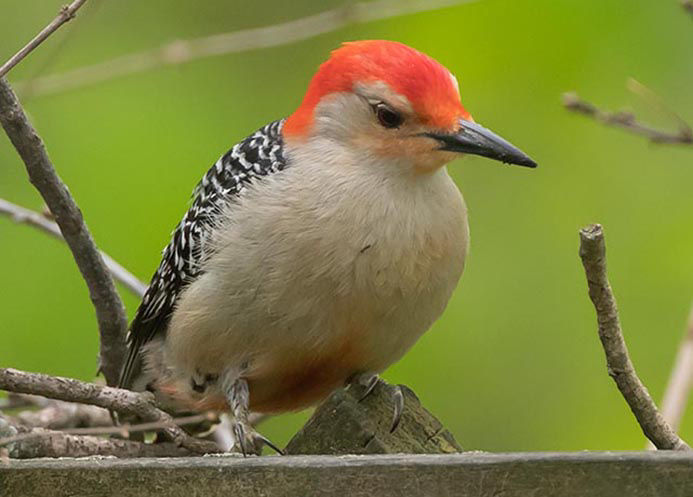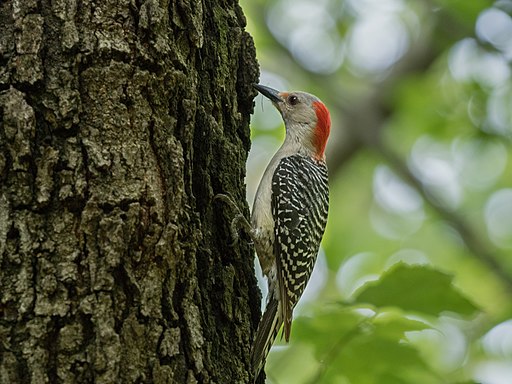Woodpeckers Unleashed: Checking Out the Marvels of These Knowledgeable Tree Climbers
Woodpeckers, with their unique markings and rhythmic drumming resembling via wooded locations, hold an unique location in the bird world - Woodpeckers in Florida. As we dig into the complex information of woodpeckers' nesting practices, feeding techniques, and the recurring preservation initiatives to protect these exceptional birds, a deeper gratitude for their place in nature unravels.
Makeup and Adaptations
When taking a look at the anatomy and adjustments of woodpeckers, one can observe impressive features that make it possible for these birds to flourish in their specialized environmental particular niche. Furthermore, woodpeckers have zygodactyl feet, with 2 toes facing onward and two facing in reverse, supplying a firm grip on tree trunks while they look for food or drum for interaction.
Furthermore, woodpeckers have a distinct tongue structure that is long, barbed, and sticky, enabling them to draw out pests from gaps in wood. This specific adaptation permits woodpeckers to manipulate a food source that is inaccessible to many various other bird varieties. In general, the makeup and adaptations of woodpeckers showcase the exceptional transformative solutions that have actually enabled these birds to flourish in their arboreal habitat.
Drumming Habits
Having actually checked out the composition and adaptations of woodpeckers, the focus now shifts to recognizing their drumming habits, an unique aspect of their interaction and territorial screens. Drumming is a vital form of interaction among woodpeckers, offering multiple functions such as developing territories, bring in friends, and signaling alarm. Each woodpecker types has a special drumming pattern that aids people recognize participants of their own varieties and differentiate them from rivals or predators.
Woodpeckers create drumming sounds by quickly pecking on powerful surfaces such as dead trees, utility posts, or perhaps metal items, developing a series of balanced beats. The strength and speed of drumming can vary based upon the purpose; for example, a rapid drumming sequence might indicate aggression towards burglars, while a slower and softer drumming pattern can indicate courtship (Woodpeckers in Florida). Furthermore, woodpeckers might readjust the regularity and duration of their drumming to convey certain messages properly
Nesting Habits
Checking out the nesting routines of woodpeckers discloses remarkable insights into their reproductive behaviors and habitat options. Woodpeckers are recognized for their one-of-a-kind nesting choices, frequently excavating tooth cavities in trees to produce protected rooms for elevating their young. These dental caries offer not just as a nesting website yet additionally as a secure refuge from killers and inclement weather.
Woodpeckers exhibit a high level of integrity to their nesting websites, usually going back to the exact same place every year. This habits highlights the value of appropriate habitat useful source accessibility for their reproductive success. The selection of a nesting site is essential for woodpeckers, with factors such as tree species, elevation, and degeneration stage playing considerable duties in their decision-making process.
Interestingly, some woodpecker types are recognized to excavate several tooth cavities within their area, offering themselves with alternative nesting alternatives. This method may serve as a form of insurance policy versus potential threats or disruptions to their main nesting site.

Feeding Techniques
Woodpeckers use a variety of specialized feeding techniques to obtain their key food resources. One of the most unique feeding habits of woodpeckers is drumming, which entails rapid pecking on trees to uncover bugs underneath check here the bark. This drumming not just aids them locate prey however likewise acts as a method of interaction with various other woodpeckers. Woodpeckers have strong, chisel-like beaks that allow them to drill into wood effortlessly. When a hole is produced, they utilize their lengthy, barbed tongues to draw out bugs visit this site such as ants, beetles, larvae, and crawlers. These tongues are covered with sticky saliva that aids trap the victim. Woodpeckers are likewise understood to excavate tooth cavities in trees to gain access to concealed insect larvae or sap. Some types, like the acorn woodpecker, shop nuts in specifically produced holes called granaries. This tactical keeping of food assists them survive during food scarcity periods. Woodpeckers are truly remarkable in their feeding strategies, showcasing flexibility and knowledge in obtaining their nutrition.
Conservation Efforts
In the middle of the elaborate feeding strategies displayed by woodpeckers, the preservation efforts aimed at guarding these remarkable birds play a vital function in preserving their habitats and populaces. Woodpeckers deal with various hazards to their survival, consisting of habitat loss as a result of logging, climate adjustment altering their communities, and collisions with synthetic structures such as structures and automobiles - Woodpeckers in Florida. Conservationists are proactively working to resolve these difficulties and ensure the lasting well-being of woodpecker varieties

Education and public recognition projects are also essential parts of woodpecker conservation initiatives. By increasing awareness concerning the significance of these birds in maintaining healthy and balanced forest ecological communities, guardians can garner assistance for habitat preservation initiatives and advertise responsible land management techniques. With joint efforts in between researchers, policymakers, and regional communities, we can interact to protect a future where woodpeckers thrive in their all-natural environments.
Final Thought
